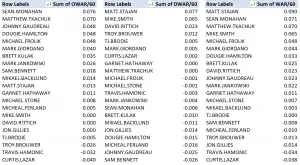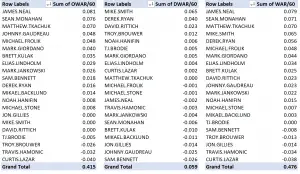Last week I published a story looking at Manny Perry’s WAR model, the Flames recent blockbuster with Carolina and the potential signing of Derek Ryan.
It was an interesting exercise to bring an subjectively weighted model into the analysis in an objective player to player standpoint. The basic summary was the Flames took a step forward in the Carolina transaction at least when it came to current NHLers (Adam Fox issue to be debated), and that adding Derek Ryan would further bolster the lineup.
Now with the Ryan signing official, we look again at said model, the new Flames roster with the surprising add of James Neal, and how the WAR model correlates with the standings from last year.
Standings and WAR
I wanted to correlate the standings to the WAR model so I pulled ice time for players to give every NHL team roughly 18 skaters.
To make the model more accurate I converted all the players to DWAR/60 (defensive WAR value over 60 minutes), OWAR/60 and WAR/60 which takes the analysis beyond simple averages and into weighting by ice time.
The Flames finished 21st offensively, 14th defensively and 20th overall in terms of WAR, exactly where they finished in last year’s standings. For the most part this was the case with 23 of the 31 teams having their WAR rank and their standings land within five spots of each other; something I’d consider pretty tight.
The outliers are interesting….
WAR Exceeds Standings
1. Montreal – The Habs had the 14th ranked offence, the 17th ranked defense and an overall 14th place finish but ended up in 28th spot in the Standings.
2. St. Louis – 27th/1st/7th vs 18th
3. Dallas – 23rd/2nd/9th vs 19th
Standings Exceed WAR
1. Vegas – The expansion club seemed pretty fortunate with the 10th ranked offence, the 24th ranked defense finishing 15th in overall WAR vs standings of 5th.
2. L.A. – 26th/9th/21st vs 12th
3. Anaheim – 18th/15th/17th vs 9th
Clearly up to interpretation, but these six teams sure leap out as first three teams that didn’t get a fair shake and then three teams that maybe won more games than the should have. Interesting that the three in the latter category were all in the Flame’s division.
The Flames 2017-18 Roster
Before we get into changes, let’s have a look at the ice time weighted WAR model for the Flames in terms of contribution. By bringing ice time into the numbers we are able to see who seems to have done the most with the ice time they’re given, pointing out players ready to pop and maybe players that could be declining.
The first thing that jumps out is the positioning of Matthew Tkachuk offensively, who almost over takes Sean Monahan when the ice time is normalized.
Defensively it’s interesting to point out that Troy Brouwer is the 2nd rated skater behind Matt Stajan, suggesting that although he has drawn the ire from the fan base and is overpaid, he’s not completely without contribution. Clearly he gives that away offensively to finish negative overall.
I’d also point out Brett Kulak dipping his toe into the upper half of the roster. The Flames may want to determine what they have in this player before they begin to make room for the next wave of emerging defensemen.
Once again, Travis Hamonic is heavily discounted to the model’s treatment of defensive defensemen, and his shooting value being so negative on the offensive side.
The Flames New Roster
Here is the Flame’s rosters after their summer remodeling.
I’ve added James Neal, Derek Ryan, Elias Lindholm and Noah Hanifin, and removed Matt Stajan and Garnet Hathaway to keep the roster at 18 skaters and three goaltenders for consistency. Austin Czarnik doesn’t make the list because of a lack of NHL ice time this past season.
 The Flames have added some offence, that much is clear, as James Neal sits atop the OWAR list eclipsing both Monahan and Tkachuk. The other three additions also add offensively to the bottom line.
The Flames have added some offence, that much is clear, as James Neal sits atop the OWAR list eclipsing both Monahan and Tkachuk. The other three additions also add offensively to the bottom line.
Defensively, Derek Ryan slots in as the new number one skater when it comes to defensive WAR with Hanifin and Lindholm also adding to the bottom line. James Neal is a slight leak on the defensive side.
The team average OWAR befdore the moves was +.358, but is now +.415 an addition of +.06. Defensively the team has gone from +.056 to +.059, an improvement, but not one that moves the needle dramatically.
But what does a +.06 move mean in the grand scheme of things? Have the Flames done enough to become a playoff team this year?
If you hold the rest of the league constant, something I chose to do to a) save myself some grief and b) avoid altering the balance of the league only part way through the roster altering off season, you do get Calgary creeping up the standings.
They move from 19th offensively to 16th, and sit flat to the 12th spot defensively. Overall their WAR rank moves from 20th to 14th and it looks like they’d grab a wild card spot.
So yes it looks like you can count on some improvement, but for the Flames to make a serious move up the standings it will have to come on the backs of internal improvement from young players, and an uptick in systems.
Can Johnny Gaudreau move the needle defensively so he’s not getting filled in on the ice? Can Sam Bennett avoid the silly penalties that has his defensive contribution a black hole? Are Bennett and Mark Jankowski ready to make a bigger impact offensively now that it appears the trickle down effect will add more quality to the third line and bottom six? And will camp competition push out a Curtis Lazar and/or a Troy Brouwer with young players bringing a bigger overall contribution?
The tenth best overall War/60 team is comes in at +.539, meaning the Flames will need to duplicate the gains made through off season change with internal advances to move from a bubble team and into secondary contender status.
It will be interesting to see how things shake out.




